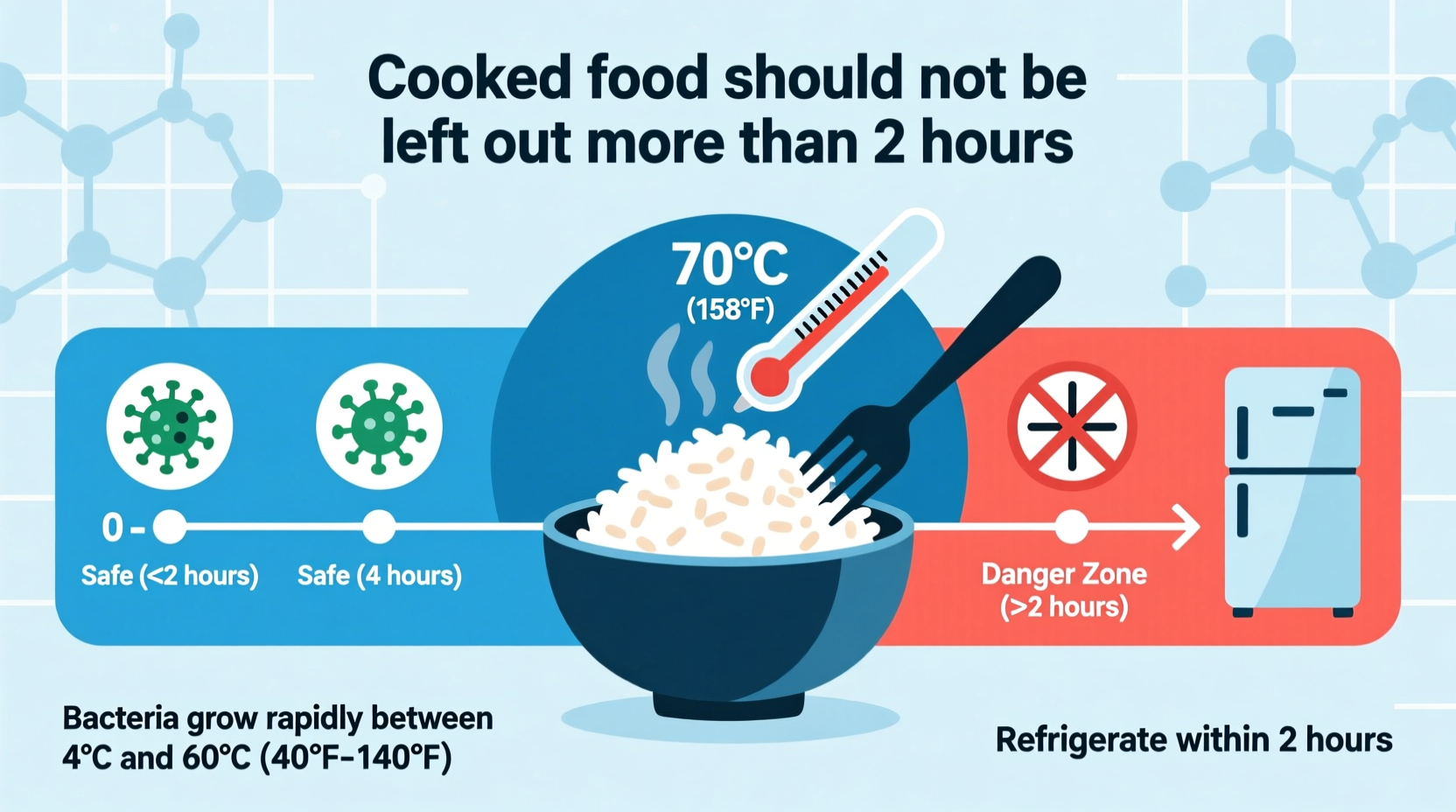Cooking food properly kills harmful bacteria, but the real danger begins after cooking when food enters the temperature danger zone. Understanding exactly how long cooked food can sit out safely is essential knowledge for preventing foodborne illness that affects millions annually. This comprehensive guide delivers science-backed food safety information you can trust, with practical guidelines for every home kitchen.
The Science Behind Food Safety Time Limits
When cooked food cools, it passes through the temperature danger zone (40°F-140°F / 4°C-60°C), where bacteria like Salmonella, E. coli, and Staphylococcus aureus can double in number every 20 minutes. The USDA Food Safety and Inspection Service confirms that after just two hours in this range, bacterial levels can reach dangerous concentrations that cooking cannot eliminate.
According to the USDA's official food safety guidelines, "perishable food should not be left out of refrigeration for more than 2 hours." This two-hour rule isn't arbitrary—it's based on extensive research into bacterial growth patterns under various temperature conditions.

Food-Specific Safety Guidelines
While the 2-hour rule applies universally, certain foods require extra caution due to their composition and susceptibility to bacterial growth. High-moisture, protein-rich foods provide ideal breeding grounds for pathogens.
| Food Type | Maximum Safe Time at Room Temperature | Special Considerations |
|---|---|---|
| Meat, poultry, seafood | 2 hours (1 hour if >90°F) | Highest risk category; contains proteins that support rapid bacterial growth |
| Dairy products, eggs | 2 hours (1 hour if >90°F) | Cream-based sauces and custards spoil faster than hard cheeses |
| Cooked rice, pasta | 2 hours | Bacillus cereus produces heat-resistant toxins after 2 hours |
| Cut fruits and vegetables | 2 hours | Higher moisture content increases risk compared to whole produce |
| Casseroles, soups, stews | 2 hours | Thick consistencies retain heat longer, extending danger zone exposure |
Temperature Matters: When the Clock Starts Ticking
The moment food drops below 140°F (60°C), the safety clock begins. Many home cooks mistakenly believe the timer starts when food reaches room temperature, but the critical period begins as soon as cooked food enters the danger zone. The FDA Food Code specifies that food service establishments must cool cooked food from 135°F to 70°F within two hours and then to 41°F or below within an additional four hours.
During summer months or in warm kitchens, the safety window shrinks dramatically. When ambient temperatures exceed 90°F (32°C), the US government's FoodSafety.gov recommends reducing the safe sitting time to just one hour. This accounts for faster temperature transition through the danger zone in warmer environments.
Practical Food Safety Strategies for Home Kitchens
Knowing how long cooked food can sit out before it goes bad is only half the solution—implementing proper food handling techniques completes the safety picture. Follow these evidence-based practices to protect yourself and your family:
Effective Cooling Techniques
- Divide and conquer: Split large quantities of food into shallow containers no deeper than 2 inches to accelerate cooling
- Ice bath method: Place food containers in ice water while stirring to rapidly lower temperature
- Specialized equipment: Use blast chillers or rapid cooling paddles for professional-grade results at home
Leftover Storage Protocol
Refrigerate leftovers within the 2-hour window, storing them in airtight containers. The CDC confirms that properly refrigerated leftovers remain safe for 3-4 days. When reheating, ensure food reaches 165°F (74°C) throughout—a food thermometer is essential for verification. Never taste food to determine safety; harmful bacteria don't always alter taste or smell.
Busting Common Food Safety Myths
Several persistent misconceptions put people at risk. The CDC reports that "many people cannot tell if a food is contaminated with disease-causing germs because food that is contaminated doesn't usually look, smell, or taste different." Let's address these dangerous myths:
- Myth: "If it smells fine, it's safe to eat"
Fact: Pathogenic bacteria like Staphylococcus produce odorless toxins - Myth: "The 2-hour rule doesn't apply to my kitchen"
Fact: Bacterial growth rates follow scientific principles regardless of kitchen cleanliness - Myth: "Reheating will kill all bacteria"
Fact: Some bacteria produce heat-stable toxins that reheating cannot destroy
Special Situations Requiring Extra Caution
Certain scenarios demand heightened vigilance. During outdoor gatherings when temperatures exceed 90°F, the safety window drops to one hour. The FDA Food Code specifically addresses these situations, noting that "time as a public health control" requires stricter monitoring in warm conditions.
When transporting food, use insulated containers with ice packs to maintain safe temperatures. For buffets, implement a strict 2-hour replacement policy for perishable items, and use chafing dishes with flame sources to keep hot foods above 140°F. The USDA emphasizes that "when in doubt, throw it out" remains the safest policy for questionable food items.











 浙公网安备
33010002000092号
浙公网安备
33010002000092号 浙B2-20120091-4
浙B2-20120091-4